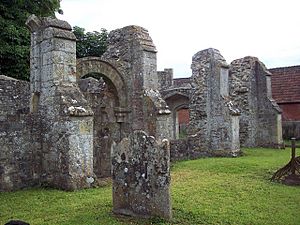St Leonard's Church, Sutton Veny facts for kids
Quick facts for kids St Leonard's Church |
|
|---|---|
 |
|
| Location | Sutton Veny, Wiltshire, England |
| Built | 12th century |
|
Listed Building – Grade II
|
|
| Official name: Church of St. Leonard | |
| Designated | 11 September 1968 |
| Reference no. | 1036423 |
| Lua error in Module:Location_map at line 420: attempt to index field 'wikibase' (a nil value). | |
St Leonard's Church in Sutton Veny, Wiltshire, England, is a very old building. It was first built in the 12th century, which means it's over 800 years old! This church is officially recognized as a Grade II listed building. This means it's an important historical site that needs to be protected. Today, St Leonard's is a redundant church, which means it's no longer used for regular church services. Instead, it's looked after by the Churches Conservation Trust, an organization that saves historic churches. The church became part of their care in 1971.
A Church with a Long History
This church was designed in a special shape called a cruciform plan, which looks like a cross from above. It was started in the 1100s and changed a few times in the 1200s and 1500s. In 1831, it had a big repair job.
Originally, this church was connected to the Priory Church of St Mary, Abergavenny. Over time, the ground around the church became damp and caused the building to sink a little. This damage was fixed by adding strong supports called buttresses in the 1300s and 1400s. But by 1866, the damage was too much. People decided to build a brand new church instead.
The new church was named after St John the Evangelist. It was designed by an architect named John Loughborough Pearson. This new church was built on higher ground, about 700 meters (or 700 yards) away from the old one. It opened its doors in 1868.
What Remains Today?
Today, only one part of the old St Leonard's Church is still in good shape. This part is called the chancel, which is the area around the altar. It was used as a special chapel for funerals. Inside the chancel, you can find old wooden boards that list donations, a bier (a stand for a coffin), a font (a basin for baptisms), and a bell. There are also memorials on the walls to remember people.
The other parts of the church, like the nave (the main part where people sit), the transepts (the arms of the cross shape), and the crossing (where the nave and transepts meet), are now in ruins. Among these ruins, you can still see a doorway from the 12th century. It might have been moved from its original spot.
Outside the church, to the southeast, there are two yew trees. One of them is very old and mostly decayed now. Its trunk measures about 14 feet and 10 inches around. We don't know how big it was when it was healthy, but it must have been huge!
See also

